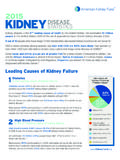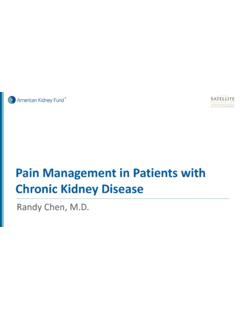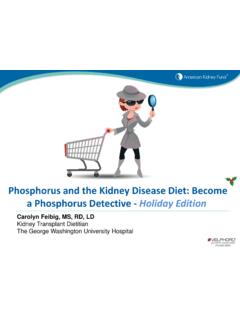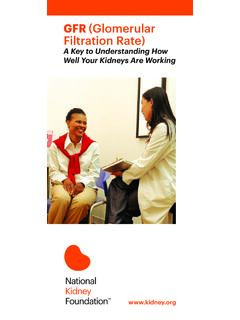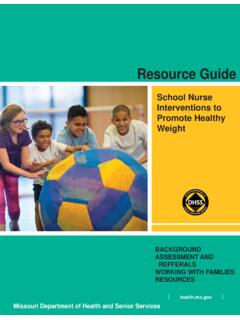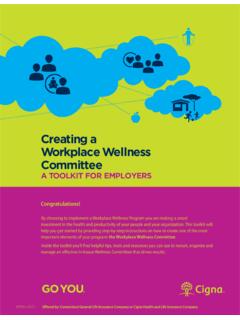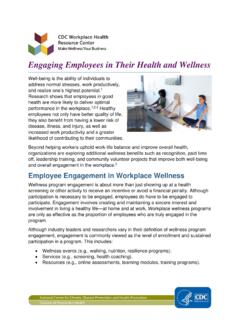Transcription of Eating Healthy with Diabetes and Kidney Disease
1 Eating Healthy with Diabetes and Kidney Disease Lori Martinez-Hassett, RD, CSR. Thanks to our speaker! Lori Martinez-Hassett, RD, CSR. Registered dietitian at Satellite Healthcare Her nutrition career and interest in Diabetes started well before her professional career, when a beloved aunt living with type 1 Diabetes taught her the art of carb counting and introduced her to an insulin pump. Learning Objectives Review common lab work for Kidney patients and how it affects food choices Learn how Kidney Disease affects blood sugar and Diabetes management Understand causes of weight changes due to Kidney Disease Food Frustration is Real Well, what can I eat? I can't have that, it's on The List . Can you just give me a meal plan to follow? There is No One Renal Diet . Nutrition needs differ from person to person Nutrition needs vary depending on stage of CKD.
2 Diet restrictions for certain nutrients like potassium, phosphorus and sodium are common Recommendations are individualized See a dietitian or ask a doctor about education classes The 3 Ps of Kidney Nutrition Protein Potassium Phosphorus Function of Protein Protein is needed for good health and . To grow our hair and nails Build/repair muscles, connective tissue Heal wounds Make hormones and enzymes Make antibodies to fight infections Protein In Our Diet Animal: meat, fish, chicken, eggs, milk (also referred to as High Biological Value HBV). Vegetable: beans, lentils, nuts and seeds Small amounts of protein in grains: cereal, bread, rice, pasta, etc. Protein In Our Diet Eat enough, but not too much Too much protein is an added burden on the kidneys Many people with Diabetes spill protein into their urine = Proteinuria Higher levels of proteinuria are associated with faster decline in Kidney function Protein for Health: Challenges As Kidney function declines people may have symptoms that make it hard to eat: - Decreased appetite - Taste changes - Nausea, vomiting Protein for Health: Challenges Proper diet is needed to maintain albumin level (protein in blood).
3 Target: albumin is ideal Low albumin levels lead to infections &. hospitalizations Also, infections, inflammation, surgeries, and fluid retention contribute to low albumin levels Protein Recommendations If you eat meat, about of protein should be from HBV protein (meat, poultry, fish, eggs, milk). Vegetarian diets are Healthy Note* that protein from beans, lentils & nuts also contain potassium and phosphorus A dietitian can help you plan a vegetarian diet Protein Recommendations Not on dialysis (Stage 4): eat LESS protein grams/kg On dialysis (Stage 5): eat MORE protein grams/kg Example of Protein Recommendations Pre-dialysis: On Dialysis: Smaller person Smaller person 135 lbs (61 kg) 135 lbs (61 kg). 50 g protein/day 79 g protein/day 4 oz/day from HBV 6 oz/day from HBV. (meat, chicken, fish, eggs). Example of Protein Recommendations Pre-dialysis On Dialysis Larger person Larger person 200 lbs (91 kg) 200 lbs (91 kg).
4 73 g protein/day 109 g protein/day 5-6 oz/day from HBV 8-9 oz/day from HBV. (meat, chicken, fish, eggs). Potassium The muscles & nerves need potassium to work High or Low potassium levels can be dangerous and affect your heart Healthy kidneys keep potassium balanced When kidneys don't work, potassium may go up Causes of Changes in Potassium Level Decline in Kidney function GI problems: poor intake, vomiting, diarrhea Various medications Salt substitutes contain KCl (potassium chloride). Food choices Dialysis choice Potassium In Our Diet Eat enough, but not too much Potassium found mainly in fruits & vegetables (also beans, lentils, nuts, milk/milk products, salt subs). 5 Servings/day of fruits & vegetables Serving size = similar to diabetic exchanges: - cup portions (light bulb sized fruit or starchy vegetable) = 15 g carb - 1 cup non-starchy vegetables = 5 grams carb Potassium In Our Diet Higher Potassium Foods Oranges Papaya Nopales Orange Juice Tomatoes Dried Beans*.
5 Bananas Potatoes Lentils*. Plantains (chips, fries, Peas*. Coconut hash browns), Nuts*. Milk/Water Yams Milk*. Persimmons Pumpkin Pomegranates Winter Squash Dried Fruit Greens Mango Artichokes *Contains potassium & phosphorus Potassium In Our Diet Lower Potassium Foods: Apples Cabbage Cranberries Carrots Blueberries Corn Raspberries Cucumbers Grapes Jicama Pears Eggplant Plums Peppers Fruit Cocktail Onions Lemon Eggplant Limes Cauliflower Rhubarb Turnips String Beans Water Chestnuts Potassium Monitoring Potassium levels can change Too High or Too Low is dangerous Symptoms are irregular heartbeat, muscle weakness Lab target: mg/dL. Type of dialysis may affect level Lower levels in home dialysis (PD) vs. hemodialysis Consult with doctor or dietitian Phosphorus Phosphorus (along with calcium) are minerals that keep our bones and teeth strong Healthy kidneys keep phosphorus and calcium in balance in the blood Phosphorus levels go up as Kidney function goes down, causing weaker bones and hardening of the heart and blood vessels Phosphorus In Our Diet Processed foods, fast food, cola drinks Contain inorganic phosphates or phosphorus additives Ex: deli meats, sausage, ham, frozen entrees, baking mixes Protein foods: Milk, cheese, yogurt, and milk products Meats and animal protein Dried beans, legumes, nuts Phosphorus In Our Diet Inorganic phosphates: >90% absorption Not on nutrition facts label Found in ingredient list: Look for Phos.
6 Phosphoric Acid, monocalcium phosphate Meats/Animal protein: 50% absorption Beans/Legumes: <40% absorption Hidden Phosphorus Find the Phosphorus . Hidden Phosphorus Leavening in baked goods: Monocalcium Phosphate Sodium Aluminum Phosphate Phosphorus Monitoring Changes in phosphorus happen early in CKD. Higher levels lead to weak bones & calcification In general, phosphorus target is < mg/dL in early stages of CKD. mg/dL CKD Stage 5. Managing Phosphorus Management is important & challenging Few symptoms Phosphorus is in many foods High levels linked with poor outcomes: higher risk of fractures and heart calcification Diet restriction Medication: phosphate binders taken with meals Dialysis In Review: 3 P's of CKD Nutrition Protein (Albumin): Stay Healthy fight infections Avoid excess protein in diet; Eat enough, but not too much Medications to help manage proteinuria (ACE/ARBS) also protect the heart Potassium: Can affect your heart rhythm If blood levels are high, then restrict high potassium foods If blood levels are low, then eat more high potassium foods, be aware of carb Phosphorus: Affects bone & heart health Food choices often recommended to stabilize glucose may be high in phos (cheese for a snack, milk at bedtime) may be high in phosphorus Target: in the 4s CKD & Diabetes : Considerations A1c is a Diabetes blood test Its accuracy may be affected by anemia Low Hemoglobin and iron deficiency Shorter red blood cell life span A1c may appear normal despite hyperglycemia Continue to check blood sugar A1c target: 7% up to 8% to avoid low blood sugar CKD & Diabetes .
7 Considerations Causes of low blood sugar Decreased intake due to symptoms of Kidney Disease Decreased appetite Nausea Taste changes Decreased clearance, or time it takes for medication to leave the body, of medication when GFR <50. Dose of medication and insulin can be decreased Higher risk with long acting meds Ex: Glyburide (long acting) often changed to Glipizide (short acting). CKD & Diabetes : Considerations Sulfonurias: Glipizide dose may be decreased Insulin: dose may be decreased Metformin: stopped when GFR <30 or creatinine > TZD (Glitazones): stopped in advanced CKD. New classes of medications: GLP-1 & DPP-4. Decreased risk of cardiovascular death Low risk of hypoglycemia + helps with weight loss CKD & Diabetes : Considerations Dialysis: Peritoneal dialysis (PD) vs. Hemodialysis PD is done at home daily PD solution (dialysate) contains dextrose which may affect blood sugars Medication or insulin dosing may need to be adjusted CKD & Weight Changes Kidneys remove both waste products and fluid As Kidney function declines.
8 Fluid can build up and cause weight gain Waste products increase and cause symptoms contributing to weight loss: Decreased appetite Taste changes Nausea/vomiting Dry Weight vs. Fluid Weight Dry weight: weight without fluid retention (build- up of fluid inside body). No swelling, not short of breath, BP better controlled Changes in dry weight occurs slowly Dry weight is not affected by dialysis Dry Weight vs. Fluid Weight Fluid weight gain due to fluid retention Clearance from kidneys decreases: pee less Worsens with high salt and/or fluid intake Symptoms: swelling, shortness of breath, rapid weight changes. Report symptoms to your doctor Fluid weight strains the heart, leads to congestive heart failure Weight Gain & Sodium Limit sodium to 2000 mg per day Read food labels No added salt and low sodium better Reduced sodium next best, may still be high in sodium Cook at home when possible Eating out: ask for no added salt or dressing on the side, avoid soups and sauces Sodium Less is Better 2400 mg/day for all Americans 1 tsp = 2400 mg tsp = 560 mg*.
9 *Sodium content of salt varies only slightly between products Sea salt is not lower in sodium! Benefits of Weight Loss First line therapy for Diabetes is Therapeutic lifestyle Changes (TCL). TLC: Includes diet & exercise Improved blood sugars & blood pressures Transplant criteria Most centers require BMI <35. BMI >25 is overweight, BMI >30 is obese Review Kidney Disease affects . Clearance of fluid: sodium & fluid restrictions Clearance of some nutrients: restrictions for potassium and phosphorus Hemoglobin, which in turn may change A1c results: continue glucose checks Clearance of meds: dosing may be decreased or stopped altogether. Talk to doctor if you have lows! Questions? Join us for our next webinar! Anxiety and Kidney Disease Thursday, December 13, 2018 from 2:00 - 3:00 EST. Join us to hear more about: How anxiety occurs What anxiety can look and feel like in a person's life How anxiety can affect quality of life for Kidney patients Chasity Shugart, LCSW-S who are pre-dialysis, on dialysis, and preparing for Medical Social Worker transplant Wellbound South Austin Tips and resources to fight and overcome anxiety Go to to learn more and register!




